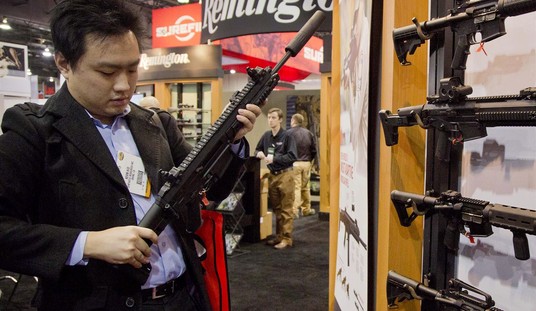Tamara Keel dryly noted yesterday that the gun control-obsessed lefties at The Atlantic seem to have a bit of a contradictory break in their “hate-hate” relationship with gun designer Eugene Stoner’s most famous creation.
So, The Atlantic wants to see some kind of legal action against Bushhamster for making the weapon used in the Sandy Hook shooting:
But wait! Isn’t this article in the same Atlantic that published the piece by Major General Scales (ret) decrying the M4 as an underpowered unreliable weapon that was getting our soldiers killed in the streets because Hamburger Hill and Black Hawk Down?
So which is it, The Atlantic? Here in reality, we know that both articles are largely wrong.
Here are the facts.
The same small-caliber (only .22) bullets common to the .223 Remington/5.56 NATO family of bullets are primarily used in the United States for punching holes in paper targets and pinging steel targets. It is also used for hunting small varmints at distance, but is banned for certain kinds of hunting in many states for being to light to humanely take thin-skinned medium-sized game animals, such as whitetail deer, much less anything larger, such as elk or bear.
They are also sometimes used in self-defense, where many firearms experts find them to be especially well-suited for home defense, as the high-speed lightweight bullets tend to to fragment and pose less of a risk of over-penetration than even some pistol bullets (this is also why AR-15s have largely replaced submachine guns on SWAT teams).
Are the 55-77-grain bullets fired by the single most common rifle sold in the United States actually “high-power?” Their power, as measured in foot/pounds of energy is roughly halfway between that of handguns and common deer rifles, such as the ubiquitous .30-’06 that Americans have hunted with and used in two World Wars (plus Korea). The .223 Remington/5.56 NATO cartridge is a light rifle cartridge, and is correctly classified as an intermediate caliber.
Someone with the ability to Google up a fact or two would know this with just a few minutes of research.
Nor, as Scales contends, has the 5.56 proven too small for most kinds of combat. The Russians were so impressed with the performance of the original 55-grain M193 round that they copied it’s best traits to come up with the 5.45-x39 for the AK-74 series of rifles. The lighter-weight 5.56 bullets did see problems is in the extended range engagements in Afghanistan. This isn’t surprising in a rifle and cartridge combination optimized for urban and suburban combat at 300 meters and closer. It simply didn’t have the range to duel with older, Russian-designed 7.62x54R (and heavier) weapons the Taliban were often firing from 500+meters away. A simple change to different cartridges featuring heavier bullets with better long-range performace went a long way towards mitigating that problem, along with a change in tactics.
Let’s be entirely clear on the Atlantic’s position.
They hate all guns (unless they’re being used by the state against rebellious citizens, of course).
They’re more than willing to lie about the AR-15 being merely a “death machine,” even though they are used in so few criminal homicides in a given year that the FBI doesn’t even track them as a class of weapon, lumping them in with rifles of all kinds. As a matter of absolute fact, while AR-15 sales continue to soar, their use (as a subset of rifles) in violent homicides continues to drop to all-time historic lows.

Yes, AR-15 rifles have been used in a small number of high-profile homicides, such as Sandy Hook and San Bernardino, but here’s a reality check for Atlantic readers.
The AR-15 is the single most ubiquitous rifle sold in the United States. There are something more than 5 million of them in common use around the nation.
It is moderately-priced, easy to learn, low-recoiling, and accurate.
Thanks to a modular design, it can be used as a “bone stock” rifle for informal target shooting (plinking) and home defense. It can also optimized for any one of a half-dozen or more different kinds of competition target shooting, and easily modified for both short and long-range shooting, depending on the user’s desires. It isn’t uncommon for AR-15 fans to have several different rifles set up for different kinds of shooting.

It can be made heavy to be stable as a long-range rifle (configurations of up to 15 lbs are not uncommon) or as light as just over four pounds for hikers and smaller-stature shooters. It can be chambered in more than 30 calibers, for shooting relatively cheap .22LR training ammunition, for shooting medium bullets at very long ranges, or for slow, heavy bullets often used to take the largest game animals in shorter ranges in heavy cover.
Put bluntly, the basic AR-15 is popular because of its inherent versatility, and obvious value. It is the Ford/Chevy/Dodge pickup of the shooting world.
The Atlantic can hate on the “modern musket” if they want, but they should at least be honest enough to admit that they hate it because “its a gun,” not because there is anything particularly wrong with the best-selling rifle in the United States.








Join the conversation as a VIP Member